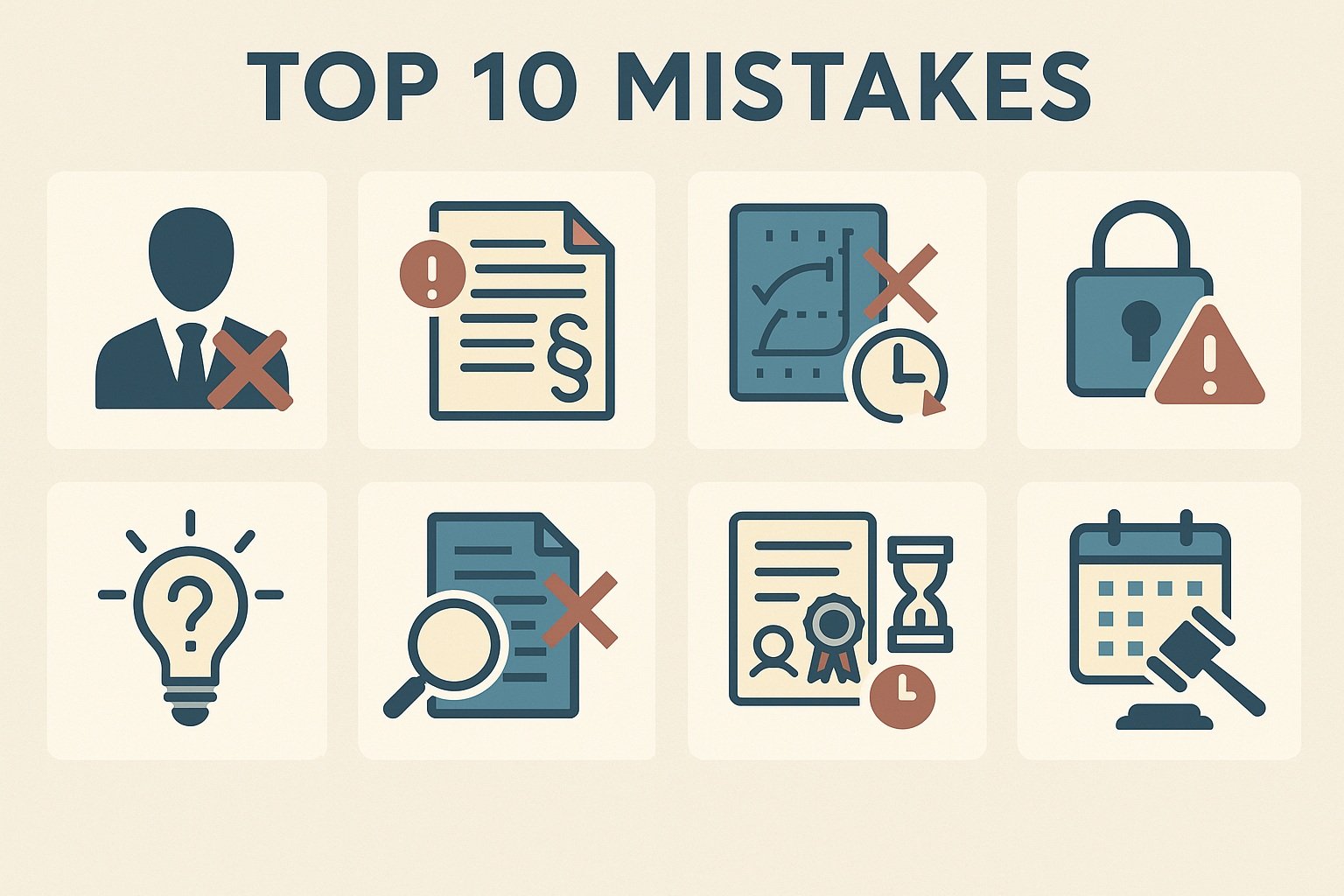Every wrong step can cost time, money, and even a complete refusal in patent protection. For foreign companies the Russian system has its own features: legislation, practice, language, procedures, judicial practice and international obligations. If you do not know the key pitfalls and do mistakes, you can face refusals or vulnerability of the patent.
Top-10 mistakes of foreign companies
Below — mistakes + real examples + how to avoid.
| № | Mistake | What can go wrong / examples | How to avoid |
|---|---|---|---|
| 1 | No patent agent registered in Russia | A foreign applicant must appoint a Russian-registered patent attorney. Without one, Rospatent will not process correspondence or may reject the application. | Always appoint a certified Russian patent attorney from the start to handle communication and filings. |
| 2 | Translation errors / inaccurate technical language | Poor translations can distort claims, reduce scope, or cause refusals. Example: “average particle size” mistranslated as “average particle diameter.” | Use professional technical translators and have translations double-checked by patent attorneys. |
| 3 | Incorrect drawings / illustrations | Drawings that don’t meet formal standards (line thickness, numbering, format) are rejected or require corrections. | Follow Rospatent drawing standards; hire professional patent illustrators familiar with Russian requirements. |
| 4 | Missing the deadline for substantive examination request | In Russia, the request must be filed within 3 years of the filing date. Miss the deadline — the application is considered withdrawn. | Set reminders, track deadlines with docketing software, and rely on local agents for monitoring. |
| 5 | Overlooking secrecy / state security review | If an invention involves sensitive technologies, filing without clearance can lead to suspension or rejection. | Review inventions for dual-use or restricted technologies; obtain export/secrecy permissions if needed. |
| 6 | Weak novelty / inventive step / industrial applicability | Vague or generic claims without proof of technical effect often get refused. | Provide clear technical examples, experimental data, and comparisons with prior art to support patentability. |
| 7 | Insufficient prior art search in Russia / EAEU | Lack of local prior art search may result in refusals during examination. | Conduct searches in Russian databases (Rospatent, EAPO) and engage local specialists to interpret results. |
| 8 | Priority claim errors | Failure to submit a certified priority document in time leads to loss of priority rights. | Prepare and file certified copies (with translations) on time; track PCT and national deadlines carefully. |
| 9 | Payment issues due to sanctions / banking restrictions | Late or failed fee payments can cause loss of rights. Sanctions complicate international transfers. | Work with Russian agents who manage payments locally; plan maintenance fees early; use reliable channels. |
| 10 | Ignoring legal updates and non-use risks | Russian law evolves; patents unused for 3+ years risk cancellation for non-use. | Monitor legal changes, document use, and consult local IP lawyers regularly to maintain enforceability. |
Practice examples of the mistakes
- One case: a European company submitted an application where in the translation “average particle size” was mistakenly translated as “average diameter of particles”, which greatly changed the meaning of the claim, and later in defense it turned out that the expected technical effect did not correspond to the claim.
- Another story: a firm filed an application but did not appoint a Russian agent — Rospatent several times returned the documents, deadlines passed, in the end the application lost priority.
- A business that left the Russian market did not use registered patents, and in 2025 lawsuits began actively from local companies about non-use, with threat of cancellation of rights.
What to do at the start to avoid mistakes: checklist for foreign companies
Here is a mini checklist from which it is worth starting, to minimize risk:
- Check legal compliance: agent, documents, authorized persons.
- Make sure of quality of translation of all materials: description, claims, drawings.
- Do prior art search (in Russia, EAEU, international databases).
- Define strategy of use: will you use in Russia, import products, have local activity.
- Prepare priority documents and compliance with terms (PCT, national phase).
- Lay budget not only for filing, but also for maintenance, possible judicial or administrative actions.
- Monitor changes in laws and judicial practice (especially on non-use, bad faith, misuse).
- Make sure drawings and illustrations comply with Rospatent and EAPO requirements.
- Check that there are no prohibitions or restrictions (for example, in case of dual-use technology, secrecy regimes, export licenses, etc.).
- Establish local support or partnership (patent attorneys, agencies, law firms with experience in RF).
About pros and cons
Not everything is black — there are opportunities, but also risks:
- Advantages: Russia — large market, strong scientific-technical base, growing interest to cooperation and innovations, stable legal system of patents and intellectual property, signing majority of international treaties.
- Risks: possible difficulties with financing (sanctions, banking restrictions), language/translation barriers, risks of court proceedings, cancellation for non-use, uncertainties connected with dual-use / secrecy.
Conclusion and recommendations
For foreign companies entering the Russian market or planning to file patents in the RF, it is important not just to “copy” the strategy that works in your country, but to adapt to local law, practice and nuances.
To avoid mistakes I recommend:
- Before filing a patent in the RF conduct audit of your patents / ideas with a Russian IP lawyer — to find out how likely passing examination is.
- Create systemic process “from project to granted patent” with control of key points (translation, agent, budget, deadlines).
- Document everything: use, marketing, sales, import — everything that can confirm that the patent is used, if there are requests on non-use.
- Do not forget about updates of legislation — sometimes even a couple of changes of wording in laws or court rulings can significantly change risks.

Leave a Reply